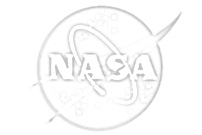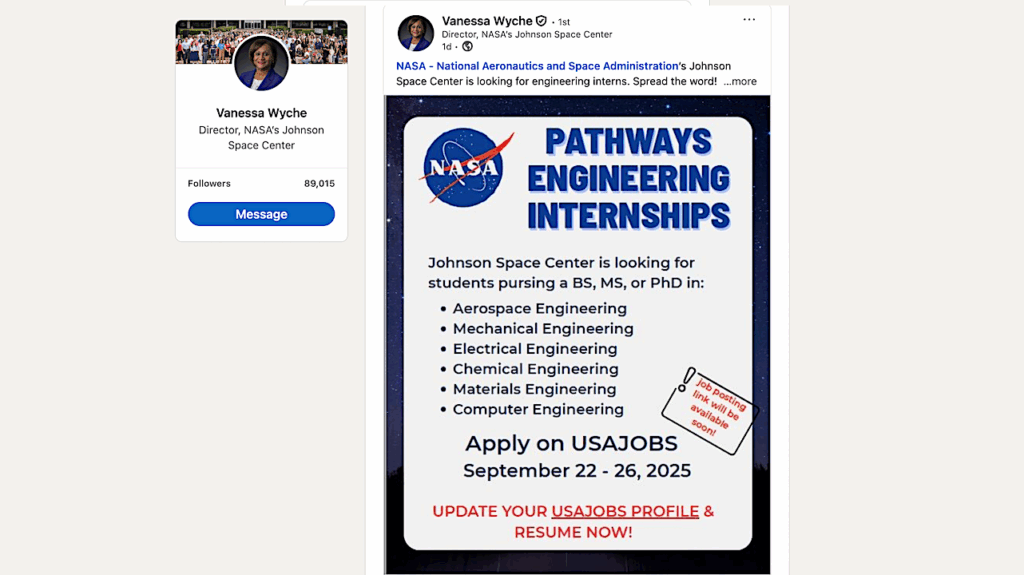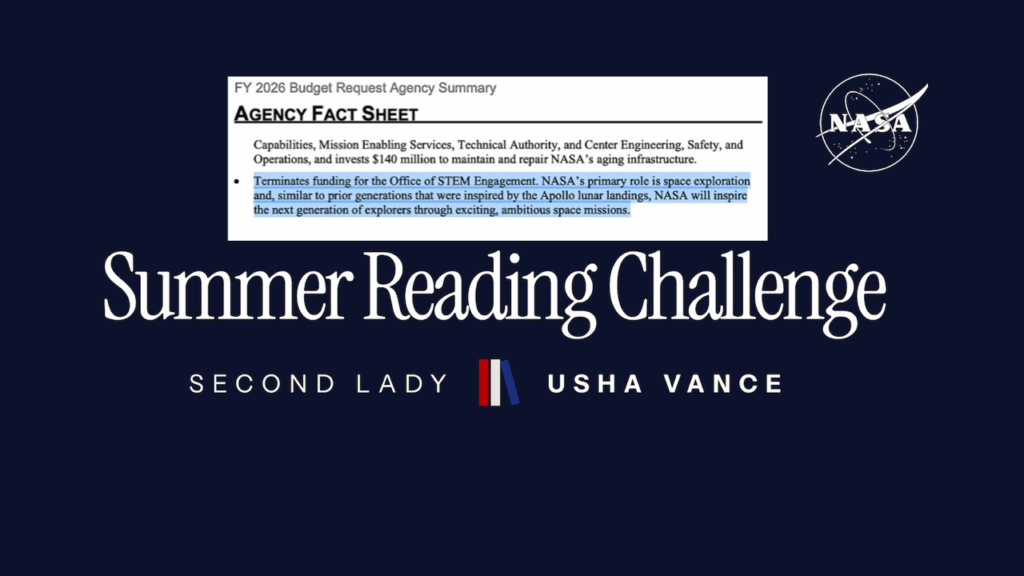Department Of Education Cubesat Challenge Totally Ignores NASA

U.S. Department of Education Launches Space Mission Challenge for High School Students, Department of Education
“Today, the U.S. Department of Education launched CTE Mission: CubeSat, a national challenge to build technical skills for careers in space and beyond. The Department invites high schools to bring space missions to students by designing and building CubeSat prototypes — in the classroom or at home. … Each finalist will receive an equal share of the $25,000 cash prize pool as well as satellite development, hardware, and software kits. Challenge sponsors include Arduino, Blue Origin, Chevron, EnduroSat, LEGO Education, Magnitude.io, MIT Media Lab, and XinaBox.”
 Keith’s note: I did a thorough check. There is no mention in this press release of NASA. Nor is there any mention of – or link to – NASA on the competition’s website. To be certain there is no law or regulation that requires that NASA be involved in everything involving space but it is weird that with the whole “Artemis Generation” thing that NASA hypes that the Department of Education makes no mention of NASA – and that NASA makes no mention of this competition.
Keith’s note: I did a thorough check. There is no mention in this press release of NASA. Nor is there any mention of – or link to – NASA on the competition’s website. To be certain there is no law or regulation that requires that NASA be involved in everything involving space but it is weird that with the whole “Artemis Generation” thing that NASA hypes that the Department of Education makes no mention of NASA – and that NASA makes no mention of this competition.
Oh yes … one other little detail: there is no mention of how the CubeSats get into space. Who launches them? Do they go up on a rocket or get tossed out of the ISS? Who pays for the ride? Details details.









If NASA is so gung ho about the “Artemis Generation”, they should be all over this. Another NASA PAO major fail.
They probably didn’t have any advance knowledge of it. Increasing students are moving beyond NASA. Look at Blue Origin’s Club of the Future. And have you seen all the neat photos of kids building SpaceX models at the SpaceX group on Facebook?
Not buying they didn’t know anything about it. Look at past NASA PAO blunders. There are plenty of them. How can you get kids interested in NASA if you do not truly reach out to them?
Do you really think that NASA is in complete control of space education in the government? That anyone that does space education has to clear it with NASA first? Also you are making the mistake in assuming interest in space requires interest in NASA. Although desirable it is not necessary.
I agree with you that interest in space doesn’t require NASA. But, at least, why not promote this program?
They are, it’s part of an ongoing STEM program at DOE. One of Education faculty says it is known among the high school teachers.
I agree that NASA is supposed to be the central national space authority for civilian purposes. Even if all NASA does is have a website which points to others as sources of contests, content, information, etc, Sadly NASA’s website(s) are so discombobulated anyone who could find anything they need would be lucky.
So neither the FCC or FAA CST have authority over civilian space activities?
BTW when it was created the Department of Education was given the authority to coordinate all federal education programs so if anything NASA should be reporting, and getting permission, from them about its space education outreach. But do you recall NASA ever asking the Department of Education for permission to engage in its space education activities?
Yes, these Washington Turf Wars could getting messy if folks start
pushing it.?
It’s not a stretch to have expected the Department of Education to have at least given NASA a heads up on this. Another example of the dysfunction of this administration and its ability to coordinate across agencies.
Why? NASA isn’t part of it. One of the problems with space policy is the belief that NASA “owns” space.
Looking at the web page and the detailed timeline, it looks like it’s up to the students to determine the requirements for their “flight event.” This bit on the page (along with one of the pictures on the site) hints at high altitude balloons:
“No material purchases are required to develop a mission proposal, but it can be helpful for teams to tinker with low-cost instruments and materials, such as computer boards, lightweight cameras, or balloon kits, as they consider what to study and how to fly their missions.”
Blue Origin is one of the sponsors so I expect there is a plan to get them into space.
Uh huh. This thing goes into great deal about everything – except how to get the satellites into space. Don’t you think someone would have posted that silly little detail if they knew?
They probably assumed folks would know that Blue Origin has its own launch systems available. But if you are wondering about it why not call their PAO? They would probably have the answers for you.
Looking at the details, this is not about having students build and fly CubeSats. They consistently uses the phrase “CubeSat prototypes” and the description is that these are not actual CubeSats. After a two step process, some would be selected for test flights on things like high altitude balloons or sounding rockets, but those “prototypes” aren’t in any way intended to be operational satellites.
Yes and this would fit in well with Jeff Bezo’s Club of the Future which has been sending student materials into space on the New Shepard.
Agreed. They are not to be space-capable, but to be an exercise in reducing the development time of cubesats. Exact quote:
“A CubeSat Prototype can be flown and tested using various flight methods
that effectively simulate a low-altitude launch, such as, but not
limited to, tethered balloons, amateur rockets, drones, or small
aircraft.”
If NASA had some role in organizing or managing the effort then NASA ought to get some credit. From what I’ve observed mainly NASA is involved in communications downlinks from astronauts to schools. That is nice; but that is outreach, not education. Decades ago there were Shuttle and Skylab students experiments. Those were organized, sponsored, and supported by NASA together with national teachers organizations often with some contractor support. I have not seen anything like that. Its nice that NASA and the US government provide an ISS, but that is not directly organizing, coordinating or supporting education; it is just relinquishing responsibility for education to someone else. NASA used to provide a lot of money for experiments and research in schools (mainly colleges). I don’t think here is much of that anymore. NASA used to write and publish lots of educational publications. I have not seen any of those in decades.
Somehow is past times NASA was able to do all the things you mention. If the education group is still as large as it used to be, why aren’t they doing these things today?
NASA supports plenty of research and experiments at colleges. It’s mostly in the form of contracts and grants to the faculty, who then hire students (undergraduate as well as graduate) to do much of the work. You’re probably thinking of direct funding by NASA for education, like the Space Grant college consortiums and at the K-12 level, that’s been more limited in recent years and the budget’s gotten tight. Also, unlike the NFS, NASA does not consider an educational element to be a plus when reviewing grant proposals. It is if it’s presented as an efficient way to get the job done (i.e. because students are chronically underpaid at most colleges), and some sort of education and public outreach is expected for major projects like Discovery missions. But proposals don’t really get bonus points for educating students as part of the proposed work.
Sounds more like NASA is using cheap student labor, rather than educating.
NASA has nothing to do with this – that is the point.
Not entirely. I’ve never proposed to NSF, but I’ve been told that in the NSF review process, having students involved helps. It’s officially part of the evaluation process and one of the criteria which can earn a proposal a higher rating. NASA’s grant review process just makes sure the time and effort, and who is doing it, are appropriate for the proposed work. If the proposal does that by hiring students, fine. If it doesn’t, that’s also fine. So NASA doesn’t have anything to do with how or if students are funded, but they also don’t offer an incentive to fund students in the way the NSF does.
From the NASA APRA call for proposals
“The participation of graduate students is strongly encouraged, especially if the project
can be concluded within the nominal tenure of graduate training. In such cases, brief
details of the educational goals and training of the participants should be included in the
proposal. Specific factors that will be considered when evaluating a proposal’s intrinsic
merit include the degree to which it advances the readiness of early-career researchers
or graduate students to assume roles in advancing NASA’s strategic objectives.”
That’s good to know. I’ve never seen anything similar in the planetary science programs (APRA is the program element for Astrophysics Research and Analysis). Is that common for the other astrophysics elements in ROSES? For the planetary programs, it definitely isn’t. I’ve seen reviewers specifically instructed not to list student involvement as a strength (unless it’s about the proposal making efficient use of resources, i.e. cheap labor.)
To my knowledge APRA is the only one that is explicit (in fact, to not have grad student involvement in a suborbital proposal is considered a fatal error). But this is because many mission PI’s were suborbital Ph.D.’s., and there is perceived to be a shortage of Ph.D.’s with hands-on space hardware experience.
Not entirely. All the universities also cover tuition for graduate students, and it’s paid for directory out of the research contracts and grants. The direct cost of the student’s time is a little debatable.
On the one hand, they are underpaid and it’s also assumed that their thesis is related to the grant, so the extra, technically unpaid time they put into their thesis work is effectively unpaid time going into the research NASA is supporting.
On the other hand, they typically take longer to do a given job, since they are both doing the job and learning how to do it. So some of the student-hours NASA ends up paying for are effectively for training and education rather than the work itself.
But, no, NASA wouldn’t pay if the statement of work said the student’s role in the project was to learn. And the grant proposal could get poor reviews if the breakdown of who is doing what didn’t make sense. So if the proposal including students in a way that _didn’t_ make the work more cost effective, then the proposal might not get selected.
Some SMD AO’s ask for optional student participation submissions – We’re doing one for SunRISE, with a bunch of students at UMich who will use the science data collected to do something other than the mission’s objectives. There’s a separate section of the proposal for it, and some additional time was allocated at the site visit.
and some money: “NASA is providing a student collaboration incentive that is defined to be 1% of the PI-Managed Mission Cost Cap.”
That’s the sort of thing I was thinking of when I mentioned Discovery missions having an education and outreach element. Unfortunately, as I understand it and unless it’s changed in the past few years, that’s reviewed and selected separately from the mission proposal itself. That is, the proposals are given reviews and ratings based on the proposed mission itself, and the mission selected for flight is chosen based on them. The educational component is reviewed and rated separately, and if NASA likes what the selected mission proposed for education, the selected mission gets that extra 1% (or however much.) But the education component doesn’t affect which mission is selected, and it’s not a point against a proposed mission if they don’t include one. Maybe you can comment on that for SunRISE.
Yes, NASA needs to do more out reach. This sounds like a typical Washington Turf War. The Department of Education is daring to trespass on NASA’s turf by a STEM program to build CubeSats to interest kids in science. I wonder what the outcry will be if the USSF follows the other services in creating a junior ROTC in High Schools as a pipeline for recruitment.
They’re not really going to space:
“A CubeSat Prototype can be flown and tested using various flight methods that effectively simulate a low-altitude launch, such as, but not limited to, tethered balloons, amateur rockets, drones, or small aircraft. “
There’s nothing in the rules about launch environments, testing, safety, etc. so my conclusion is that this is a “build models with arduinos” kind of thing. Cool, but not really a cubesat (or a “sat”) of any kind.
Interesting stuff can be done with a tiny payload (few grams) and inexpensive helium balloons for lift (as in party balloons, not weather balloons). I’ve got a friend who has sent several such things half way around the world. The last one seems to have stopped transmitting somewhere over Mongolia.
Example at: https://www.qrp-labs.com/li…